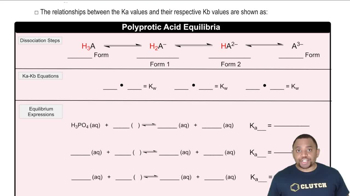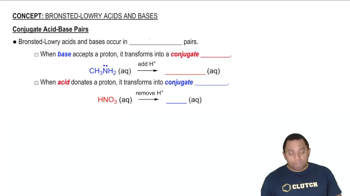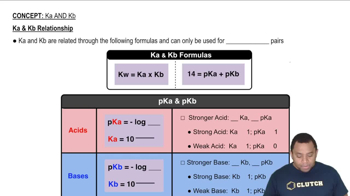Here are the essential concepts you must grasp in order to answer the question correctly.
Acid-Base Equilibrium
Acid-base equilibrium refers to the balance between acids and bases in a solution, characterized by the dissociation of acids into protons (H+) and their conjugate bases. The strength of an acid is quantified by its acid dissociation constant (Ka), while the strength of a base is measured by its base dissociation constant (Kb). Understanding this equilibrium is essential for calculating Kb from Ka values.
Recommended video:
Triprotic Acid Equilibrium
Conjugate Acid-Base Pairs
Conjugate acid-base pairs consist of an acid and its corresponding base that differ by a single proton. For example, when fluoride ion (F-) acts as a base, it can accept a proton to form its conjugate acid, HF. The relationship between Ka and Kb for a conjugate pair is given by the equation: Ka × Kb = Kw, where Kw is the ion product of water (1.0 x 10^-14 at 25°C).
Recommended video:
Conjugate Acid-Base Pairs
Calculating Kb from Ka
To calculate Kb from Ka, one can use the relationship between the two constants and the ion product of water. Specifically, Kb can be determined using the formula Kb = Kw / Ka. This calculation is crucial for determining the basicity of ions like fluoride, allowing for a deeper understanding of their behavior in aqueous solutions.
Recommended video:

 Verified step by step guidance
Verified step by step guidance


